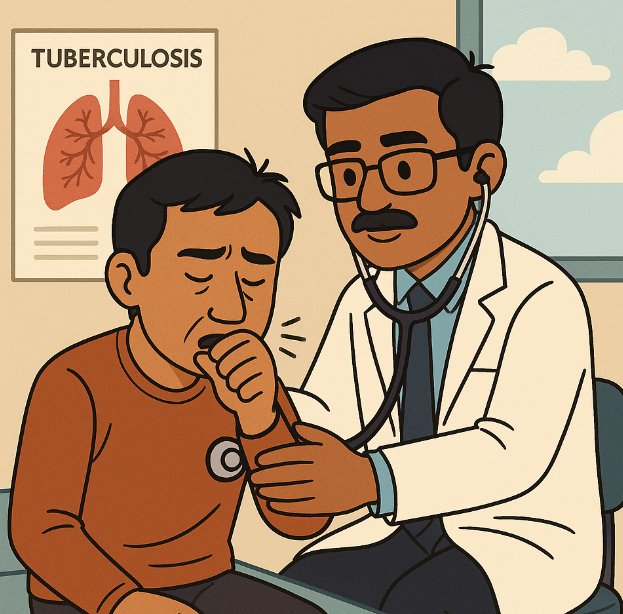
What This Study Reveals About TB Stigma in India
Last year, India recorded nearly 3 million cases of tuberculosis (TB) and over 340,000 deaths. But beyond the biology of infection lies another challenge—one that rarely makes it into program reports or media headlines. TB stigma continues to derail care, deepen inequities, and cost lives.
A new narrative review published in PLOS Global Public Health pulls together 44 studies from across India, showing how stigma—social rejection, discrimination, and internal shame—shapes every stage of the TB journey. The findings are urgent for practitioners, policymakers, and communities working to end TB.
A Day in the Life: Stigma at Every Turn
Picture a young woman in Mumbai who develops a persistent cough. She worries more about her neighbors finding out than about the illness itself. If her employer learns of a TB diagnosis, she could lose her job as a domestic worker. Even within her home, fear lingers: Will her in-laws send her away?
This story isn’t unusual. Studies show that 60–70% of people with TB hide their diagnosis from neighbors and colleagues, fearing gossip, isolation, or rejectionjournal.pgph.0005109. For women, the stakes are even higher—marriage prospects, family acceptance, and household stability often hang in the balance.
The Four Faces of TB Stigma
Researchers classify TB stigma into four types:
- Anticipated stigma: Fear of being labeled or rejected.
- Perceived community stigma: Beliefs that others view people with TB as dangerous or deviant.
- Enacted stigma: Actual experiences of exclusion, job loss, or verbal abuse.
- Internalized stigma: When individuals adopt negative stereotypes about themselves.
The review found that while enacted stigma (direct discrimination) is less common, anticipated and perceived stigma are widespread. In other words, even the fear of rejection keeps people from seeking care, sticking with treatment, or disclosing their illness.
Gender: A Double Burden
The evidence is stark: women face more stigma, and less support.
- Married women were more likely to hide their diagnosis, even from their husbands.
- Families were more likely to withdraw support from female patients than from men.
- Marriage prospects suffered for women with TB—and sometimes even for their sisters or daughtersjournal.pgph.0005109.
Meanwhile, men’s main concern was often lost wages. Women worried about abandonment. This imbalance reflects broader gender inequities in India, where stigma compounds existing vulnerabilities.
Why Stigma Matters for Public Health
Stigma isn’t just a social harm—it’s a public health threat. The review found strong evidence linking stigma to:
- Delayed diagnosis: People waited months before seeking help.
- Poor adherence: Some stopped treatment to avoid being seen at DOTS centers.
- Mental health strain: Those experiencing stigma had two to three times higher odds of depression and anxietyjournal.pgph.0005109.
One study reported that people with high stigma had 20 times higher odds of non-adherence to TB treatment. For a disease that requires six months or more of daily medication, these numbers signal major challenges for India’s End TB Strategy.
What Works: Interventions on the Table
The review highlights potential interventions at every level.
- Community education: School programs, social media, and even puppet shows to challenge myths about TB.
- Support groups & TB clubs: Safe spaces for people with TB and their families to share experiences, reduce isolation, and build resilience.
- Healthcare worker training: Programs that encourage compassion and reduce discriminatory behavior. Physicians who received training were three times more likely to show empathy.
- Celebrity campaigns: Leveraging popular figures to reduce stigma and normalize care-seeking.
- Workplace protections: Policies to safeguard jobs and reduce fear of disclosure.
The message is clear: tackling stigma requires both policy innovation and community participation.
Lessons for Public Health Practice
For public health departments, NGOs, and frontline workers, this review underscores three key lessons:
- Measure stigma, not just incidence. Stigma is a hidden variable that explains why people delay care or drop out of treatment.
- Center women in TB programs. Gender-responsive approaches are not optional—they are critical.
- Invest in mental health and social support. Treating TB without addressing depression, shame, and fear is like patching a roof while leaving holes in the walls.
What’s Next?
The authors call for more research on stigma reduction strategies, adapted to India’s diverse cultural contexts. While interventions like TB clubs and counseling show promise, they must be carefully designed to avoid reinforcing stigma.
Globally, TB stigma echoes lessons from HIV: biomedical progress alone won’t end epidemics without addressing fear, discrimination, and inequity.
Join the Conversation
Stigma is harder to quantify than sputum smears, but its effects are just as real. This review is a reminder that ending TB requires dismantling not just bacteria, but barriers.
Questions for readers:
- How could your agency integrate stigma reduction into TB programs?
- What role can community leaders or workplaces play in supporting people with TB?
- Does this research challenge how you think about equity in prevention and care?



